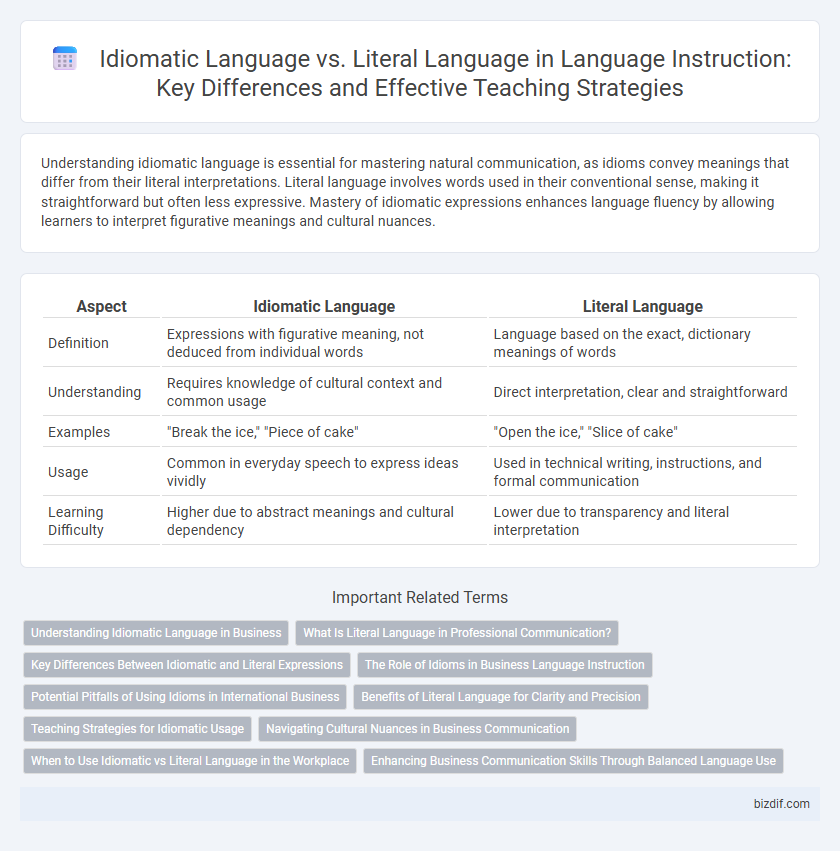Understanding idiomatic language is essential for mastering natural communication, as idioms convey meanings that differ from their literal interpretations. Literal language involves words used in their conventional sense, making it straightforward but often less expressive. Mastery of idiomatic expressions enhances language fluency by allowing learners to interpret figurative meanings and cultural nuances.
Table of Comparison
| Aspect | Idiomatic Language | Literal Language |
|---|---|---|
| Definition | Expressions with figurative meaning, not deduced from individual words | Language based on the exact, dictionary meanings of words |
| Understanding | Requires knowledge of cultural context and common usage | Direct interpretation, clear and straightforward |
| Examples | "Break the ice," "Piece of cake" | "Open the ice," "Slice of cake" |
| Usage | Common in everyday speech to express ideas vividly | Used in technical writing, instructions, and formal communication |
| Learning Difficulty | Higher due to abstract meanings and cultural dependency | Lower due to transparency and literal interpretation |
Understanding Idiomatic Language in Business
Understanding idiomatic language in business enhances communication by capturing cultural nuances and conveying complex ideas succinctly. Idiomatic expressions often reflect industry-specific jargon and established practices, making literal translations ineffective and potentially misleading. Mastering these idioms improves clarity, builds rapport with international partners, and fosters more effective negotiations.
What Is Literal Language in Professional Communication?
Literal language in professional communication involves using words and expressions according to their explicit, dictionary definitions without any figurative or symbolic meaning. It ensures clarity and precision, crucial for avoiding misunderstandings in business documents, emails, and presentations. Employing literal language enhances effective information transfer by focusing on straightforward, unambiguous messages.
Key Differences Between Idiomatic and Literal Expressions
Idiomatic language consists of phrases whose meanings cannot be deduced from the individual words, such as "kick the bucket," meaning to die, whereas literal language conveys the exact, dictionary definitions of words. Idiomatic expressions often reflect cultural nuances and are context-dependent, making them challenging for language learners to interpret correctly. Literal expressions provide clarity and directness, essential for precise communication and language instruction.
The Role of Idioms in Business Language Instruction
Idioms play a crucial role in business language instruction by enhancing learners' understanding of culturally specific expressions that convey complex ideas succinctly. Mastery of idiomatic language helps professionals communicate more naturally and persuasively in negotiations, presentations, and daily interactions, improving clarity and rapport with colleagues and clients. Teaching idioms alongside literal language enables learners to navigate subtle nuances and avoid misunderstandings in global business environments.
Potential Pitfalls of Using Idioms in International Business
Idiomatic language often confuses non-native speakers due to cultural nuances and non-literal meanings, leading to misinterpretations in international business communications. Literal language provides clarity by conveying direct, universally understood messages, reducing the risk of misunderstanding among diverse teams. Misuse of idioms can result in weakened business relationships, lost deals, and damaged corporate reputations in a global marketplace.
Benefits of Literal Language for Clarity and Precision
Literal language enhances clarity and precision by conveying exact meanings without ambiguity, making it ideal for technical writing and formal communication. Its straightforward nature helps avoid misunderstandings, especially in instructional or professional contexts where accuracy is crucial. Using literal language supports clear comprehension and effective information transfer across diverse audiences.
Teaching Strategies for Idiomatic Usage
Effective teaching strategies for idiomatic usage emphasize contextual learning, where students encounter idioms through authentic texts and conversations that highlight meaning beyond literal interpretation. Incorporating multimedia resources such as videos and dialogues enhances comprehension by illustrating idiomatic expressions in real-life scenarios. Frequent practice with role-plays and interactive activities encourages active use, facilitating internalization and accurate application of idiomatic language.
Navigating Cultural Nuances in Business Communication
Idiomatic language often conveys meanings shaped by cultural context that literal language cannot capture, making it essential for effective business communication across diverse markets. Understanding idioms specific to a culture enhances clarity and builds trust, reducing the risk of misunderstandings in negotiations and collaborations. Mastery of these linguistic nuances supports smoother interactions and fosters stronger international business relationships.
When to Use Idiomatic vs Literal Language in the Workplace
Idiomatic language enhances communication by conveying cultural nuances and emotional subtleties, ideal for informal workplace interactions and team-building conversations. Literal language ensures clarity and precision, essential for formal documents, technical writing, and situations requiring unambiguous instructions. Understanding context and audience allows professionals to choose idiomatic expressions for engagement or literal language for accuracy and professionalism.
Enhancing Business Communication Skills Through Balanced Language Use
Mastering idiomatic language alongside literal language enhances clarity and cultural nuance in business communication, improving negotiation and relationship-building. Using idiomatic expressions appropriately signals proficiency and fosters trust, while literal language ensures precision and reduces misunderstandings. Balanced language use equips professionals to adapt messages effectively across diverse audiences, boosting overall communication impact.
Idiomatic language vs literal language Infographic

 bizdif.com
bizdif.com